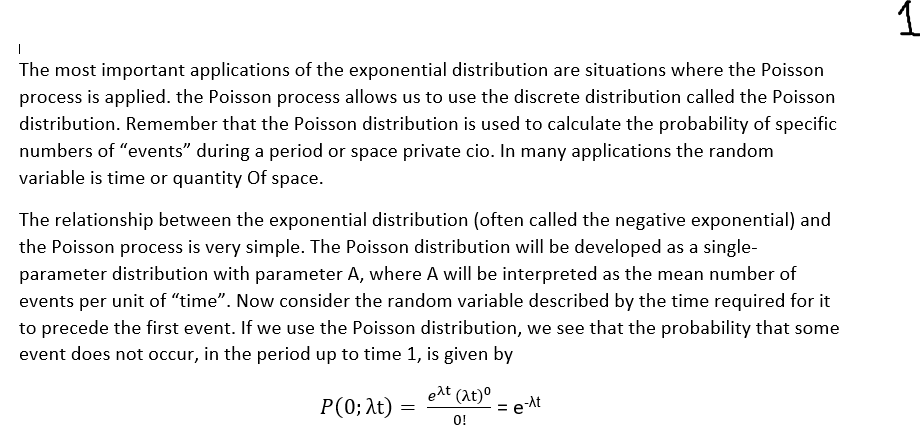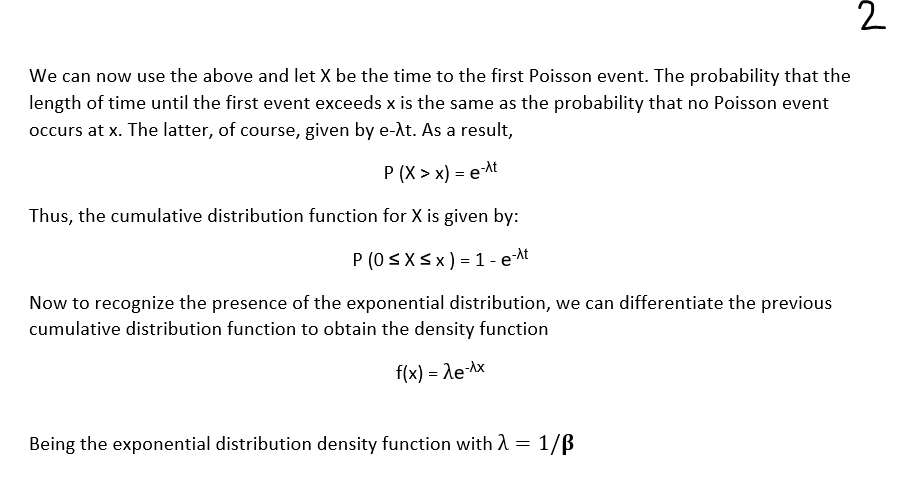The most important applications of the exponential distribution are situations where the Poisson process is applied. the Poisson process allows us to use the discrete distribution called the Poisson distribution. Remember that the Poisson distribution is used to calculate the probability of specific numbers of "events" during a period or space private cio. In many applications the random variable is time or quantity of space. The relationship between the exponential distribution (often called the negative exponential) and the Poisson process is very simple. The Poisson distribution will be developed as a single- parameter distribution with parameter A, where A will be interpreted as the mean number of events per unit of "time". Now consider the random variable described by the time required for it to precede the first event. If we use the Poisson distribution, we see that the probability that some event does not occur, in the period up to time 1, is given by
The most important applications of the exponential distribution are situations where the Poisson process is applied. the Poisson process allows us to use the discrete distribution called the Poisson distribution. Remember that the Poisson distribution is used to calculate the probability of specific numbers of "events" during a period or space private cio. In many applications the random variable is time or quantity of space. The relationship between the exponential distribution (often called the negative exponential) and the Poisson process is very simple. The Poisson distribution will be developed as a single- parameter distribution with parameter A, where A will be interpreted as the mean number of events per unit of "time". Now consider the random variable described by the time required for it to precede the first event. If we use the Poisson distribution, we see that the probability that some event does not occur, in the period up to time 1, is given by
MATLAB: An Introduction with Applications
6th Edition
ISBN:9781119256830
Author:Amos Gilat
Publisher:Amos Gilat
Chapter1: Starting With Matlab
Section: Chapter Questions
Problem 1P
Related questions
Question
Hello! I need help explaining with general words the following fragment of a text about Poisson and mention what is the relationship between the Poisson and exponential distribution according to the text
I put it in two photos so that it can be appreciated better
I put it in two photos so that it can be appreciated better

Transcribed Image Text:|
The most important applications of the exponential distribution are situations where the Poisson
process is applied. the Poisson process allows us to use the discrete distribution called the Poisson
distribution. Remember that the Poisson distribution is used to calculate the probability of specific
numbers of "events" during a period or space private cio. In many applications the random
variable is time or quantity of space.
The relationship between the exponential distribution (often called the negative exponential) and
the Poisson process is very simple. The Poisson distribution will be developed as a single-
parameter distribution with parameter A, where A will be interpreted as the mean number of
events per unit of "time". Now consider the random variable described by the time required for it
to precede the first event. If we use the Poisson distribution, we see that the probability that some
event does not occur, in the period up to time 1, is given by
P(0; λt)
=
eat (at)⁰
0!
=
e-At
1

Transcribed Image Text:2
We can now use the above and let X be the time to the first Poisson event. The probability that the
length of time until the first event exceeds x is the same as the probability that no Poisson event
occurs at x. The latter, of course, given by e-λt. As a result,
P (X> x) = e-^t
Thus, the cumulative distribution function for X is given by:
P (0 ≤ x ≤ x) = 1 - e-^t
Now to recognize the presence of the exponential distribution, we can differentiate the previous
cumulative distribution function to obtain the density function
f(x) = λe-^x
Being the exponential distribution density function with λ = 1/B
Expert Solution
This question has been solved!
Explore an expertly crafted, step-by-step solution for a thorough understanding of key concepts.
Step by step
Solved in 3 steps

Recommended textbooks for you

MATLAB: An Introduction with Applications
Statistics
ISBN:
9781119256830
Author:
Amos Gilat
Publisher:
John Wiley & Sons Inc

Probability and Statistics for Engineering and th…
Statistics
ISBN:
9781305251809
Author:
Jay L. Devore
Publisher:
Cengage Learning

Statistics for The Behavioral Sciences (MindTap C…
Statistics
ISBN:
9781305504912
Author:
Frederick J Gravetter, Larry B. Wallnau
Publisher:
Cengage Learning

MATLAB: An Introduction with Applications
Statistics
ISBN:
9781119256830
Author:
Amos Gilat
Publisher:
John Wiley & Sons Inc

Probability and Statistics for Engineering and th…
Statistics
ISBN:
9781305251809
Author:
Jay L. Devore
Publisher:
Cengage Learning

Statistics for The Behavioral Sciences (MindTap C…
Statistics
ISBN:
9781305504912
Author:
Frederick J Gravetter, Larry B. Wallnau
Publisher:
Cengage Learning

Elementary Statistics: Picturing the World (7th E…
Statistics
ISBN:
9780134683416
Author:
Ron Larson, Betsy Farber
Publisher:
PEARSON

The Basic Practice of Statistics
Statistics
ISBN:
9781319042578
Author:
David S. Moore, William I. Notz, Michael A. Fligner
Publisher:
W. H. Freeman

Introduction to the Practice of Statistics
Statistics
ISBN:
9781319013387
Author:
David S. Moore, George P. McCabe, Bruce A. Craig
Publisher:
W. H. Freeman